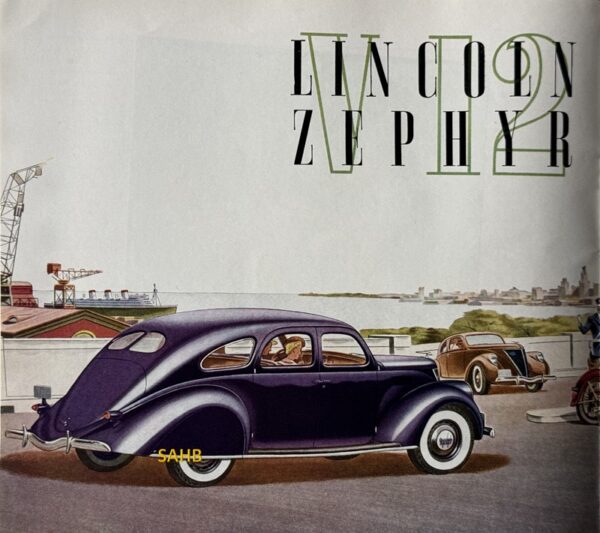
The decade before World War II can rightly be described as a ‘Golden Age’ for motor car advertising. This week’s Snapshot is one such example: it comes from a 1936 issue of the American news magazine Time. The use of illustration rather than photography enabled Lincoln to create imagery that subtly alluded to the lifestyle of a Lincoln-Zephyr owner, without having to go to the trouble of arranging a photo-shoot with an ocean liner, two cars, several passengers and a motorcycle policeman.
The Lincoln-Zephyr was a line of luxury cars produced by the Lincoln division of Ford from 1936 until 1942. It bridged the gap between the Ford V8 DeLuxe and the Lincoln Model K in both size and price. It thus expanded Lincoln’s offering into a second model line that could compete with the Chrysler Airflow, Cadillac’s LaSalle marque, and the Packard One-Twenty.
The Lincoln-Zephyr was conceived by Edsel Ford and designed by E.T. Gregorie. It was introduced on 2 November 1935 as a 1936 model. Its modern design featured a low-raked windscreen, integrated wings, and streamlined aerodynamic fastback styling that influenced its name: ‘Zephyr’ was derived from the Greek word zephyrus, or the god of the west wind. The Lincoln-Zephyr was a success: the combination of a stylish exterior and a V12 engine had strong appeal. It revived sales at Lincoln dealerships in the late 1930s: in its first year, 15,000 Lincoln-Zephyrs were sold. This may have been small beer in American market terms, but it represented 80% of Lincoln sales that year.
The designer E.T. Gregorie was an interesting character. Eugene Turenne ‘Bob’ Gregorie (1908-2002) was born into a family of considerable wealth. His father was a very successful investor and his mother an acclaimed painter. Summer holidays were spent in the surroundings of elegant yachts on the Long Island Sound and the Chesapeake Bay. Gregorie sketched what he saw and became fascinated by marine design. The prestigious naval design firm of Cox & Stevens (later known as Gibbs & Stevens) gave Gregorie his training.
In 1929 Gregorie began his career in automotive design at General Motors; sadly for him, he was soon let go during the economic crisis. But a chance (or deliberate?) meeting with Edsel Ford led to his hiring by the Ford Motor Company in 1932 at the age of 22.
Edsel Ford was a cultured man, and he and Gregorie got on well together. Gregorie became chief of Ford’s new design department in 1935; his most renowned creations were the 1936 Lincoln-Zephyr, the 1939 Lincoln Continental, and the 1949 Mercury, the latter made famous by James Dean in Rebel Without a Cause.
Image courtesy of The Richard Roberts Archive: www.richardrobertsarchive.org.uk







Leave a Comment